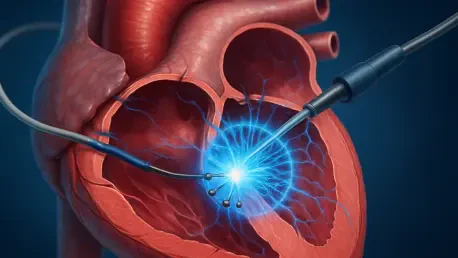Imagine a world where life-threatening conditions like atrial fibrillation or cancer can be treated with pinpoint precision, minimal risk, and faster recovery times, thanks to the rapid evolution of pulsed field ablation (PFA) and pulsed electric field treatments. These technologies are reshaping the medical technology landscape by offering nonthermal alternatives to traditional ablation methods, promising safer and more effective solutions for patients worldwide. This roundup gathers insights, perspectives, and strategic tips from various industry stakeholders to explore how companies like Pulse Biosciences, Galvanize Therapeutics, and Del Medtech are driving this transformation. The purpose is to illuminate the diverse approaches, challenges, and opportunities in this dynamic field, offering a comprehensive view of PFA’s impact on medtech.
Exploring the PFA Revolution in Medical Technology
Why PFA Is Capturing Industry Attention
Pulsed field ablation stands out due to its nonthermal mechanism, which avoids the collateral damage often associated with conventional thermal ablation techniques like radiofrequency or cryotherapy. Industry analysts highlight that this approach minimizes risks such as tissue scarring or unintended burns, making it a compelling choice for cardiac and oncological treatments. The precision of PFA allows for targeted destruction of problematic cells while preserving surrounding healthy tissue, a feature that many see as a game-changer for patient safety.
Feedback from medtech innovators suggests a growing consensus on PFA’s potential to address unmet needs in chronic disease management. Beyond safety, the technology offers shorter procedure times, which could reduce hospital stays and healthcare costs. However, some caution that widespread adoption hinges on robust clinical data to prove long-term outcomes, a concern echoed across regulatory and medical communities.
A differing viewpoint comes from healthcare providers who note that while PFA shows promise, integrating it into existing clinical workflows poses logistical challenges. Training staff and updating equipment are significant hurdles, especially for smaller facilities with limited budgets. Despite these concerns, the enthusiasm for nonthermal ablation remains high, fueled by its potential to redefine treatment standards.
Setting the Context for Corporate Pioneers
The rise of PFA has spurred intense activity among leading medtech companies, each carving out unique paths to innovation. Pulse Biosciences, Galvanize Therapeutics, and Del Medtech represent a cross-section of strategies, from regulatory milestones to funding triumphs and bold diversification. Industry observers point out that their collective efforts reflect a broader trend toward minimally invasive solutions in healthcare, driven by patient demand for better outcomes.
Stakeholder perspectives vary on the pace of this transformation. Some believe the momentum behind PFA signals a tipping point for medtech, while others argue that the technology must overcome skepticism from traditionalists who favor established methods. This roundup delves into these contrasting views, drawing from a range of opinions to paint a nuanced picture of the field’s current state.
Company Spotlights: Innovations and Insights
Pulse Biosciences’ Regulatory Milestone in Cardiac Care
Pulse Biosciences has garnered significant attention with its FDA investigational device exemption (IDE) approval for a PFA study focused on atrial fibrillation during cardiac surgery. Industry commentators describe this as a landmark achievement, positioning the company at the forefront of cardiac innovation. The NANOCLAMP AF study, involving 136 patients across 20 global sites, aims to demonstrate the technology’s safety and speed compared to thermal methods.
Regulatory experts emphasize that achieving IDE approval reflects rigorous scrutiny and a strong preliminary case for PFA’s efficacy. However, they also warn that proving long-term effectiveness against entrenched techniques remains a steep challenge. The balance between innovation and evidence is a recurring theme in discussions about Pulse’s path forward.
Hospital administrators offer a practical take, noting that while the potential for faster, safer procedures is enticing, the cost of adopting new systems could strain resources. Their input underscores a broader concern about scalability, even as optimism persists about PFA’s role in transforming cardiac care. This mix of excitement and caution shapes the narrative around Pulse’s pioneering efforts.
Galvanize Therapeutics’ Funding Surge and Strategic Growth
Galvanize Therapeutics recently secured $100 million in Series C funding, a move that industry insiders view as a strong vote of confidence from investors like Sofinnova Partners and Intuitive Surgical. The capital is earmarked for scaling the Aliya platform for tumor ablation and advancing the RheOx system for chronic bronchitis. Many see this financial backing as a catalyst for expanding PFA’s reach into oncology and respiratory care.
Leadership transitions also play a role in Galvanize’s story, with the appointment of a seasoned CEO bringing expertise from past successes in medtech acquisitions. Strategic analysts suggest that such experience could sharpen the company’s competitive edge, though rapid expansion carries risks like overextension or market saturation. This duality of opportunity and challenge is a focal point in evaluations of Galvanize’s trajectory.
Oncology specialists provide a clinical perspective, praising the Aliya platform’s potential to target solid tumors with minimal invasiveness. Yet, they also stress the need for extensive real-world data to validate outcomes across diverse patient populations. These insights highlight the importance of balancing growth ambitions with grounded, evidence-based progress in PFA applications.
Del Medtech’s Ambitious Diversification into New Fields
Del Medtech, a newer player, is making waves by exploring PFA applications beyond cardiac care, targeting areas like gastroenterology, oncology, and men’s and women’s health. Industry pioneers commend this bold vision, estimating a market potential ranging from $1.4 billion to $7.4 billion annually, with growth rates projected at 9% to 13% over the coming years. The focus on single-use ablation devices is seen as aligning with trends toward cost-effective, disposable tools.
Market analysts, however, question whether success in cardiology will seamlessly translate to other specialties, given the unique demands of each field. They argue that scaling across multiple domains requires tailored approaches, not a one-size-fits-all strategy. This skepticism adds a layer of complexity to the optimism surrounding Del Medtech’s expansive goals.
Feedback from device developers suggests that partnerships will be critical for navigating these uncharted territories. Collaborations with established players could mitigate risks, offering resources and expertise to bridge gaps in specialized markets. This perspective underscores a strategic tip for emerging companies: leveraging alliances to bolster innovation in diverse therapeutic areas.
Broader Implications for the Medtech Landscape
Shifting Paradigms in Patient Care
Nonthermal ablation technologies like PFA are poised to address critical gaps in treating chronic and life-threatening conditions, according to a wide array of industry voices. Their ability to minimize damage to healthy tissue while targeting diseased cells is frequently cited as a breakthrough for improving patient outcomes. This shift is seen as a direct response to long-standing challenges in conventional therapies.
Comparative analyses of Pulse, Galvanize, and Del Medtech reveal distinct yet complementary strategies—regulatory focus, commercial scaling, and therapeutic diversification, respectively. Investment experts speculate that their successes could spur broader funding trends in medtech, encouraging venture capital to prioritize nonthermal innovations. Such ripple effects are anticipated to reshape industry priorities over time.
A fresh angle emerges from patient advocacy groups, who highlight how these advancements could democratize access to cutting-edge care. If costs decrease and availability increases, underserved populations might benefit significantly. This societal impact adds depth to the discussion, framing PFA as not just a technological leap but a potential equalizer in healthcare delivery.
Strategic Lessons for Industry Stakeholders
Key achievements across these companies offer valuable lessons for medtech players. Pulse’s regulatory milestone demonstrates the importance of aligning with stringent standards to gain credibility, while Galvanize’s funding success underscores the power of investor trust in fueling growth. Del Medtech’s bold entry into varied fields serves as a reminder of the rewards—and risks—of thinking beyond traditional boundaries.
For industry participants, actionable steps include prioritizing clinical research to build a robust evidence base for PFA, a point stressed by many research directors. Forming strategic partnerships is another widely recommended tactic to accelerate market entry and share development burdens. These approaches can help navigate the competitive and complex landscape of nonthermal technologies.
Healthcare providers and investors also receive tailored guidance from this roundup. Providers are encouraged to assess infrastructure readiness for adopting PFA systems, while investors should focus on startups with clear clinical and commercial roadmaps. These practical insights aim to equip stakeholders with tools to engage effectively with this evolving sector.
Reflecting on a Pivotal Moment in Medtech
Looking back, the collective advancements by Pulse Biosciences, Galvanize Therapeutics, and Del Medtech marked a defining chapter in the journey of pulsed field ablation and nonthermal treatments. Their strides in regulatory approvals, funding achievements, and ambitious diversification painted a picture of an industry on the cusp of transformation. The diverse opinions and insights gathered from industry stakeholders illuminated both the promise and the hurdles that shaped this era of innovation.
Moving forward, stakeholders are encouraged to deepen their engagement with clinical trials and collaborative ventures to solidify PFA’s standing in mainstream healthcare. Exploring hybrid models that combine PFA with other emerging technologies could unlock new treatment possibilities. Additionally, keeping a pulse on global regulatory shifts will be vital to anticipate and adapt to changing standards. These steps offer a roadmap for sustaining momentum and ensuring that the benefits of nonthermal ablation reach patients across varied medical landscapes.









